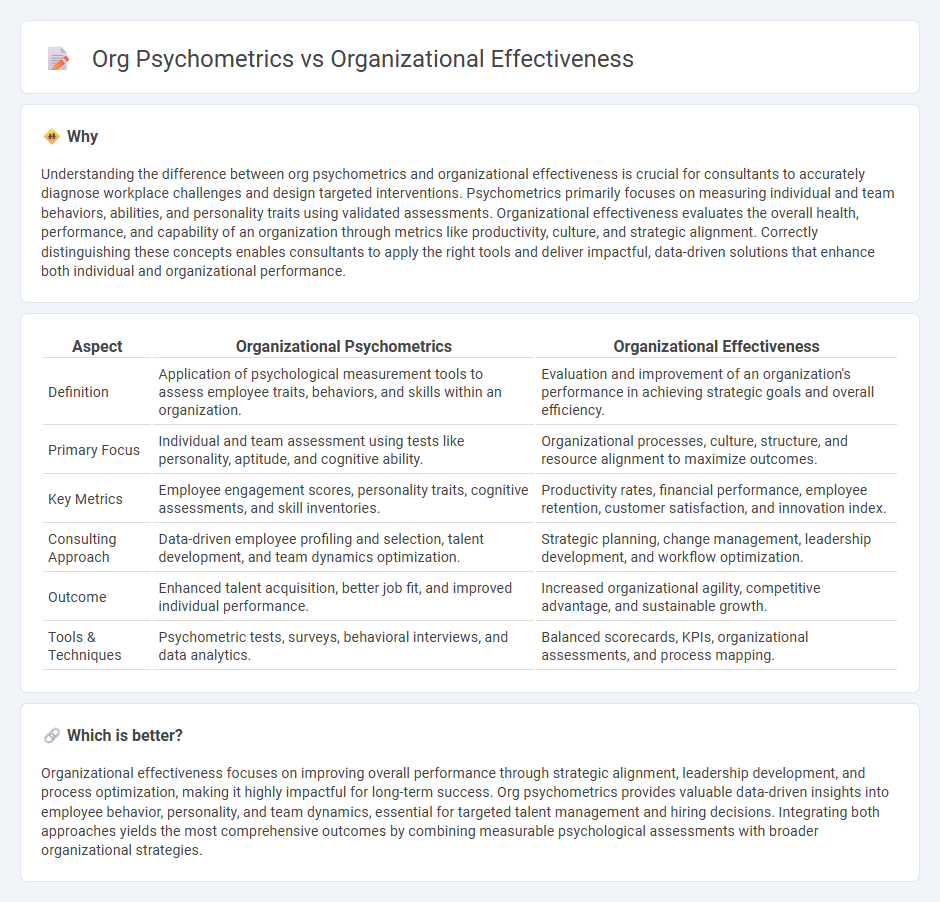
Organizational psychometrics involves measuring employee behaviors, attitudes, and personality traits to enhance workplace dynamics and predict performance outcomes. Organizational effectiveness focuses on aligning strategies, processes, and culture to achieve business goals and improve overall productivity. Explore how leveraging psychometric data can drive targeted interventions for superior organizational effectiveness.
Why it is important
Understanding the difference between org psychometrics and organizational effectiveness is crucial for consultants to accurately diagnose workplace challenges and design targeted interventions. Psychometrics primarily focuses on measuring individual and team behaviors, abilities, and personality traits using validated assessments. Organizational effectiveness evaluates the overall health, performance, and capability of an organization through metrics like productivity, culture, and strategic alignment. Correctly distinguishing these concepts enables consultants to apply the right tools and deliver impactful, data-driven solutions that enhance both individual and organizational performance.
Comparison Table
| Aspect | Organizational Psychometrics | Organizational Effectiveness |
|---|---|---|
| Definition | Application of psychological measurement tools to assess employee traits, behaviors, and skills within an organization. | Evaluation and improvement of an organization's performance in achieving strategic goals and overall efficiency. |
| Primary Focus | Individual and team assessment using tests like personality, aptitude, and cognitive ability. | Organizational processes, culture, structure, and resource alignment to maximize outcomes. |
| Key Metrics | Employee engagement scores, personality traits, cognitive assessments, and skill inventories. | Productivity rates, financial performance, employee retention, customer satisfaction, and innovation index. |
| Consulting Approach | Data-driven employee profiling and selection, talent development, and team dynamics optimization. | Strategic planning, change management, leadership development, and workflow optimization. |
| Outcome | Enhanced talent acquisition, better job fit, and improved individual performance. | Increased organizational agility, competitive advantage, and sustainable growth. |
| Tools & Techniques | Psychometric tests, surveys, behavioral interviews, and data analytics. | Balanced scorecards, KPIs, organizational assessments, and process mapping. |
Which is better?
Organizational effectiveness focuses on improving overall performance through strategic alignment, leadership development, and process optimization, making it highly impactful for long-term success. Org psychometrics provides valuable data-driven insights into employee behavior, personality, and team dynamics, essential for targeted talent management and hiring decisions. Integrating both approaches yields the most comprehensive outcomes by combining measurable psychological assessments with broader organizational strategies.
Connection
Organizational psychometrics provides quantitative tools to measure employee behaviors, cognitive abilities, and personality traits, which are essential for diagnosing organizational health and predicting performance outcomes. These psychometric assessments inform strategic interventions in leadership development, team dynamics, and talent management, directly enhancing organizational effectiveness by aligning human capital with business goals. Integrating psychometrics in consulting enables data-driven decision-making that optimizes workforce productivity and drives sustainable organizational success.
Key Terms
Performance Metrics
Organizational effectiveness measures overall success by evaluating performance metrics such as productivity, employee engagement, and financial outcomes to align with strategic goals. Organizational psychometrics, on the other hand, focuses on assessing individual behaviors and cognitive abilities through data-driven tools like personality tests and aptitude assessments to enhance workforce capabilities. Explore deeper insights into how integrating these performance metrics with psychometric analysis drives sustainable organizational growth.
Employee Engagement
Organizational effectiveness measures how well a company achieves its goals, while organizational psychometrics uses psychological tools to assess employee traits and behaviors, particularly focusing on employee engagement levels. Employee engagement, a critical driver of productivity and retention, is quantified through psychometric assessments that evaluate motivation, satisfaction, and alignment with organizational values. Explore deeper insights into how integrating psychometric data can enhance strategies for boosting employee engagement and overall organizational effectiveness.
Assessment Tools
Organizational effectiveness relies heavily on assessment tools that measure performance, employee engagement, and leadership capabilities to drive strategic decisions. Organizational psychometrics offers scientifically validated instruments such as personality tests, cognitive ability assessments, and behavioral surveys that provide deep insights into workforce dynamics. Explore the most advanced assessment tools in organizational effectiveness and psychometrics to enhance your talent management strategies.
Source and External Links
Organizational effectiveness: the X factor for company success - Organizational effectiveness measures how thoroughly and efficiently a company achieves its business goals through strategy, metrics, commitment, behaviors, and culture, with a focus on long-term success.
Organizational Effectiveness : Meaning, Importance ... - Organizational effectiveness is the capacity of a business to efficiently attain its objectives by optimizing resources, streamlining processes, and fostering adaptive leadership and communication.
What is organizational effectiveness: Key factors to achieve ... - It refers to how well an organization meets its goals and operates efficiently, impacting financial performance, employee engagement, adaptability, and sustainable growth.
 dowidth.com
dowidth.com